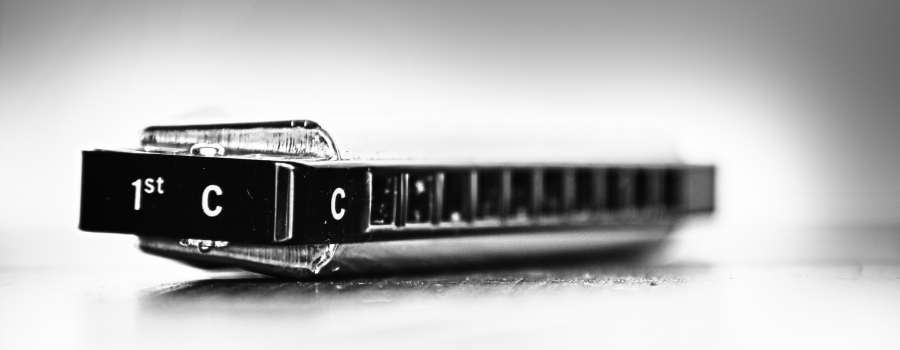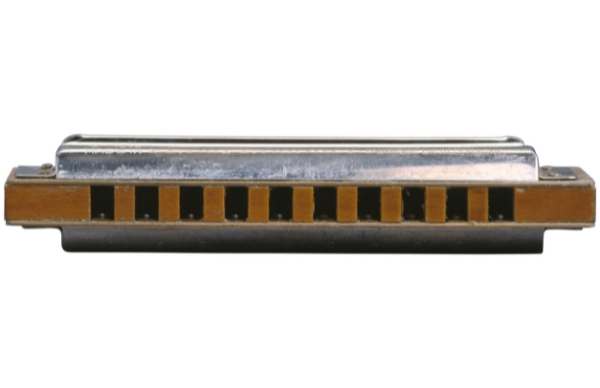
For as small as harmonicas are, they have fairly complicated mechanics that allow them to work. More than just two metal plates with a series of holes on either side, the inner working of a harmonica is actually pretty complex.
In the rest of this article, I will describe how harmonicas work in more detail. This will include how they use the same basic principle to make so many different sounds and how a typical harmonica is arranged.
How Do Harmonicas Work?
Generally, harmonicas produce sounds as air is either blown or drawn through the tone holes. Reeds inside the instrument will vibrate at different frequencies which will produce different notes. Variations in tone, such as bends, are produced with hand and mouth movements.
Whether you are inhaling or exhaling, your breath passes by metal prongs called reeds. These metal reeds (usually made of brass) react to the air and start vibrating. This vibration in turn affects the air as it passes. By interrupting the airflow the harmonica makes sounds.
If you’re familiar with reed instruments, you might expect that the sounds are generated by the vibrating reed. While it is the reed that helps create the sound, it is not the source. Instead, the sounds are created by the airflow being interrupted. The mechanics are more similar to a siren than a reed instrument like a clarinet.
This is made possible by the design of the harmonica.
Harmonicas are made of five main parts:
- Two cover plates
- Blow reed plate
- Draw reed plate
- Comb
The holes on the mouth side of the harmonica direct your breath into the comb. From there it is directed to the blow reed plate, causing the reeds to vibrate. Finally, it exits out the other side.
You are able to play the harmonica by exhaling or inhaling because of the two reed plates. The blow reed plate is oriented so that the reeds are inside the comb. This allows them to vibrate as you blow air out of the comb. The draw reed plate is placed so that the reeds are on the outside of the comb. This setup allows you to set them to vibrate when you draw air into the comb.
How Do Harmonicas Make Different Sounds?
The most basic way to make different sounds with a harmonica is to blow or draw air through a different hole. How you shape your mouth, place your tongue and hands, and vary the airflow is more advanced methods for varying a harmonicas sound.
The various advanced methods all work for different reasons. That said, the basic principle is that you can affect the air going into and coming out of the harmonica with the aspects mentioned above. Many of these techniques take years to perfect. However, even a beginner can learn to do some of the simpler techniques for different sounds.
For example, you can change the number of notes you’re playing by using your tongue. This is an alternative method to puckering which allows you to do the same thing. Once you learn how to do tongue blocking you can learn how to switch rapidly between notes for great effect. Techniques such as tongue slap, flutter, and octaving all rely on how you move your tongue.
As for the basic methods, it’s determined by the length of the reeds for each hole. Longer reeds vibrate more slowly so they produce a lower note. Shorter reeds do the opposite. The different holes serve the same purpose as the keys on a piano. With as simple as the instrument is, there is some complexity when it comes to the notes produced by the different holes.

How Are Notes Arranged On A Harmonica?
A diatonic harmonica has 10 holes that can produce 19 different notes. The notes are arranged from low to high pitch. Low pitches are on the left with progressively higher pitch notes on the right. Each hole can play two different notes depending on whether you are blowing or drawing air.
Since there are 10 holes and you can play different notes based on blowing or drawing, you would expect to be able to play 20 notes. This is not the case. There is one note that is repeated which makes it 19. However, this is further complicated by advanced harmonica techniques. With techniques called bending, overblowing, and overdrawing you can play upwards of 34 notes.
Back to the basics, harmonica notes are referred to by the number of the hole and the direction of the air. The home note on a C-harp is hole 4 blow or simply blow 4. This note is a C note since the harmonica is tuned to C Major, also known as Richter tuning. A Richter tuned harmonica has the notes arranged in the pattern below.
| Hole | 1 | 2 | 3 | 4 | 5 | 6 | 7 | 8 | 9 | 10 |
| Blow | C | E | G | C | E | G | C | E | G | C |
| Draw | D | G | B | D | F | A | B | D | F | A |
Hole 1 has the longest reeds while hole 10 has the shortest. As mentioned above, this is what determines the pitch. So “blow” 1 is a much lower C than “blow” 10. The proper way to hold a harmonica makes it so that the low pitches are on the left. Typically the blow reed plate is on the top in this configuration. That said, you can hold the harmonica “upside-down” if you want.
Final Thoughts
Now you know the basics of harmonica mechanics and how they work. Though there is still much to learn about these fascinating instruments, you have a better grasp of the basics.
You know that the reeds in a harmonica are not the source of the notes like the reed of a saxophone is. But like many other wind instruments, your mouth and how you hold the harmonica are very important to the sound. Lastly, similar to a piano, the lower-pitched notes are on the left while higher-pitched ones are on the right.
